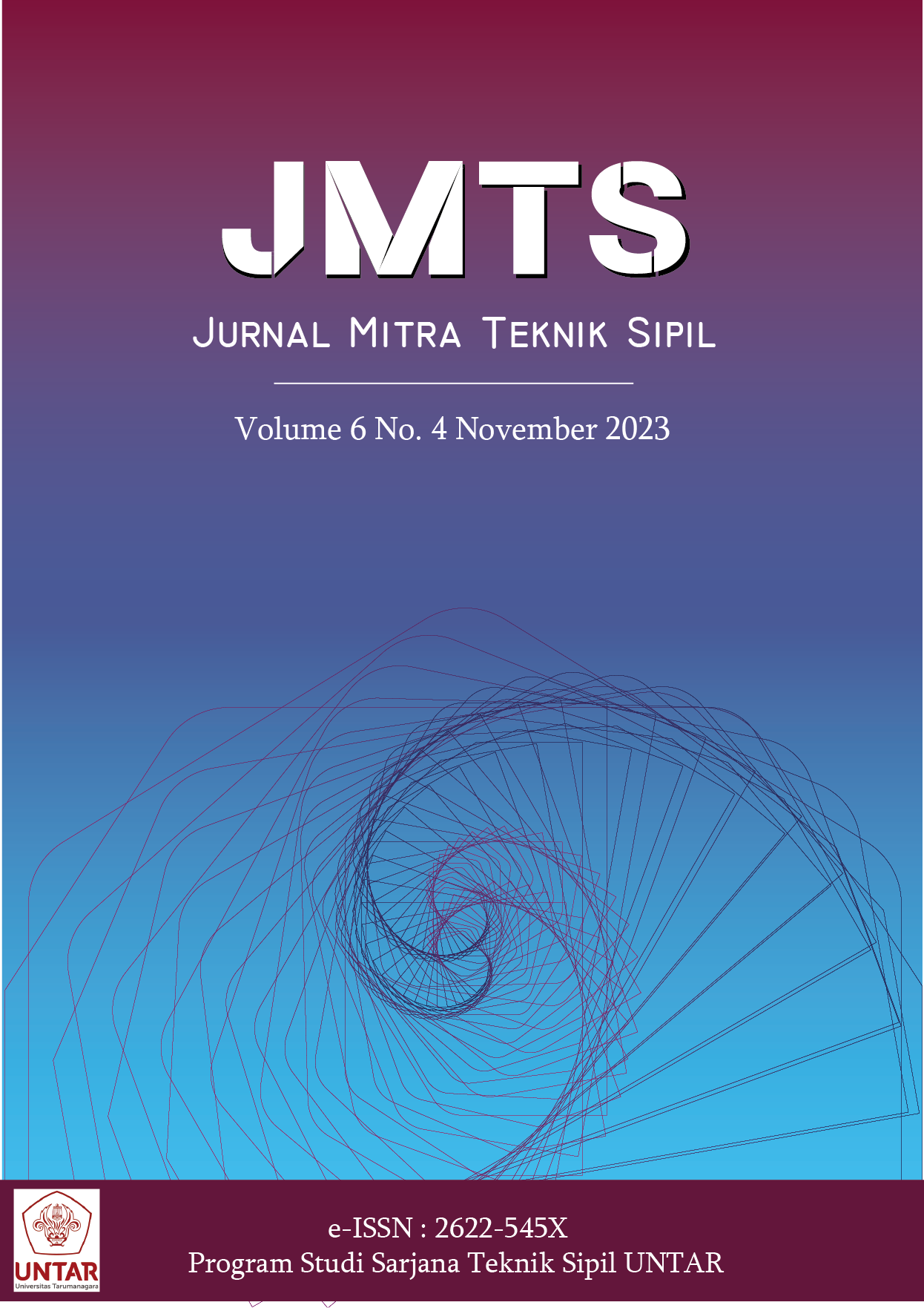ANALISIS PERBANDINGAN POTENSI CYCLIC MOBILITY PADA TANAH LEMPUNG DI BEBERAPA TEMPAT DI INDONESIA
Main Article Content
Abstract
Liquefaction is a phenomenon which carrying capacity in soil decreases due an ongoing earthquake. There are two types of liquefaction, namely flow liquefaction and cyclic mobility. The institution in Indonesia that involved in this case, needs to understand again one of the types of liquefaction that occurs, namely cyclic mobility. There are 4 locations in Indonesia that are compared, which one has the potential. The first thing to do when analyzing liquefaction is check the susceotibility for soil characteristics. Vulnerability examination uses four methods, namely Seed et al, Chinese criteria, Bray and Sancio, and Tsuchida method. If the soil shows liquefaction susceptibility, the research is continued to state criteria, if there is no vulnerability, no need to continued state criteria. Determination of the liquefaction type can be seen from the state criteria method in the graph of the relationship between axial strain (εa) and deviatoric stress (q). To check the potential of the liquefaction using the cyclic strain approach method. This method uses cyclic stress ratio (CSR) and the cyclic resistance ratio (CRR). These variables are obtained from calculations on field tests. The field tests used are bore logs and N-SPT report. This study analyzes the cyclic mobility potential in the soil based on the safety factor that will be obtained later. The output of the case occurs that the type of liquefaction that occurs is cyclic mobility and there is potential for liquefaction in clay soils.
Abstrak
Likuifaksi adalah suatu fenomena dimana daya dukung tanah berkurang akibat gempa yang sedang berlangsung. Likuifaksi ada dua jenis yaitu likuifaksi cair dan mobilitas siklik. Lembaga yang berperan dalam hal ini di Indonesia perlu memahami lagi salah satu jenis likuifaksi yang terjadi yaitu mobilitas siklik. Ada 4 daerah yang akan menjadi perbandingan dalam penelitian ini. Hal pertama dilakukan saat menganalisis likuifaksi adalah pengecekan terhadap potensi rentan dari karakter tanah. Pengecekan potensi rentan memakai empat metode yaitu; metode Seed et al. Chinese criteria metode Bray dan Sancio, dan Tsuchida. Jika menunjukkan kerentanan likuifaksi, penelitian dilanjutkan kriteria komposisi, jika tidak ada kerentanan tidak usah dilanjutkan kriteria kompisi. Penentuan tipe likuifaksi dilihat dari metode state criteria pada grafik triaksial hubungan antara gaya aksial (εa) dan tekanan deviatorik (q). Ada 2 metode yang digunakan yaitu rasio resisntensi siklik (CRR) dan rasio tegangan siklik (CSR). Variabel didapat dari perhitungan tes lapangan. Tes lapangan yang dipakai adalah data bor atau N-SPT. Penelitian ini menganilisa potensi likuifaksi pada tanah berdasarkan faktor keamanan yang nanti akan didapat, yang pada akhirnya membuktikan bahwa likuifaksi yang terjadi adalah mobilitas siklik dan berpotensi pada tanah lempung. Lalu hasil yang didapat membuktikan bahwa sebagian daerah berpotensi mobilitas siklik, dan sebagian tidak berpotensi.
Article Details

This work is licensed under a Creative Commons Attribution-NonCommercial-ShareAlike 4.0 International License.
This work is licensed under Jurnal Mitra Teknik Sipil (JMTS) Creative Commons Attribution-ShareAlike 4.0 International License.References
Bray, J. D., & Sancio, R. B. (2006). Assessment of the liquefaction susceptibility offine-grained soils. Journal of Geotechnical and Geoenvironmental Engineering, 132(9), 1165–1177. https://doi.org/10.1061/(ASCE)1090-0241(2006)132:9(1165)
Fernando, N., & Prihatiningsih, A. (2019). Analisis potensi cyclic mobility pada tanah kohesif. JMTS: Jurnal Mitra Teknik Sipil, 2(3), 77-85. https://doi.org/10.24912/jmts.v2i3.5811
Januar, K., & Susilo, A. J. (2022). Pengecekan penampang fondasi tiang terhadap fenomena likuifaksi akibat gempa. JMTS: Jurnal Mitra Teknik Sipil, 5(4), 735–750. https://doi.org/10.24912/jmts.v5i4.20269
Kramer, S. L. (1996). Geotechnical earthquake engineering. Prentice Hall. http://faculty.washington.edu/kramer/GEEbook.pdf
Schneider, J. A., & Mayne, P. W. (2000). Soil liquefaction response in mid-america evaluated by seismic piezocone tests. Atlanta: Georgia Institute of Technology. http://mae.cee.illinois.edu/publications/reports/Report00-03.pdf
Seed, H. B., & Idriss, I. M. (1971). A simplified procedure for evaluating soil liquefaction potential. Journal of Soil Mechanics and Foundation Division, 97(9), 1249-1273. https://doi.org/10.1061/JSFEAQ.0001662
Seed, R. B., Cetin, K. O., Moss, R. E. S., Kammerer, A. M., Wu, J., Pestana, J. M., Riemer, M. F., Sancio, R. B., Bray, J. D., Kayen, R. E., & Faris, A. (2003). Recent advances in soil liquefaction engineering: A unified and consistent framework. Proceedings of the 26th Annual ASCE Los Angeles Geotechnical Spring Seminar: Long Beach, CA. https://digitalcommons.calpoly.edu/cgi/viewcontent.cgi?article=1007&context=cenv_fac
Siahaan, S. P. O. (2015). Percobaan potensi likuifaksi pada tanah pasir seragam dengan permodelan alat di laboratorium [Tugas Akhir, Universitas Andalas]. http://scholar.unand.ac.id/754/1/Saut%20Siahaan.pdf
Tsuchida, H. (1970). Prediction and countermeasure against the liquefaction in sand deposits. Abstract of the Seminar in the Port and Harbour Research Institute.
Wang, W. S. (1979). Some findings in soil liquefaction. Chinese Journal of Geotechnical Engineering, 2(3), 55-63. http://manu31.magtech.com.cn/Jwk_ytgcxb/EN/



